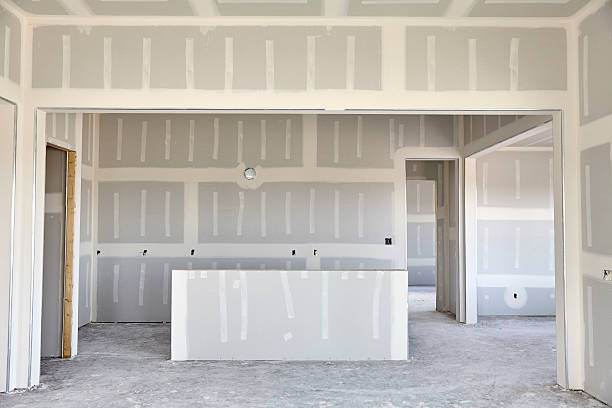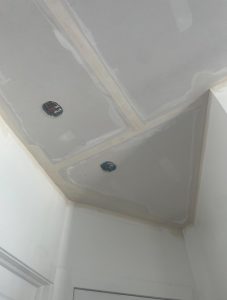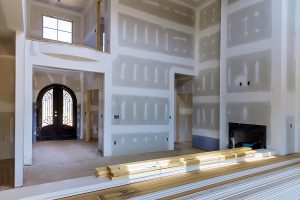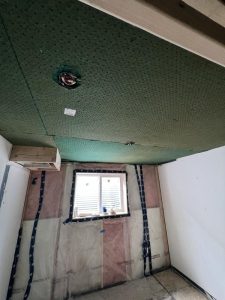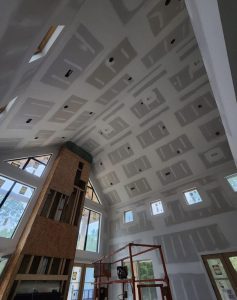Drywall installation and finishing in large residential homes are critical steps in the overall construction process. When done correctly, it provides a flawless, smooth, and durable surface that enhances the interior aesthetics of a home. However, drywall can be susceptible to various issues, particularly in large residential projects where factors like structural settling, temperature variations, and high humidity levels can create challenges.
For homeowners in Victoria and elsewhere, it’s essential to understand the common problems that can occur during drywall installation and finishing, along with strategies to prevent them. Addressing these concerns proactively can save time, effort, and money, ensuring a superior end result.
1. Cracks in Drywall Joints
Why It Happens:
Cracks in drywall joints are one of the most common issues homeowners encounter, particularly in large homes. These cracks can appear due to the natural settling of the building’s foundation, temperature changes, or poor installation techniques. In large residential projects, expansive walls and ceilings are especially prone to cracks because structural shifts in the home can cause additional stress on the drywall seams.
Cracks usually appear at the corners of walls, around doors and windows, or in long sections of drywall where joint stress is most pronounced. This is a significant concern for homeowners in Victoria, where varying weather conditions can affect the moisture content and structure of the home.
How to Prevent It:
- Ensure proper installation techniques are used by experienced professionals to reinforce drywall joints. Using materials like mesh tape or fiber tape, rather than paper tape, can provide additional strength and flexibility.
- For large homes, it’s advisable to use flexible joint compounds that can accommodate slight movements within the walls without cracking.
- Allow the home’s structure to settle properly before completing the drywall finishing. This is particularly important in new residential builds where the foundation may take some time to stabilize.
- Control humidity and temperature fluctuations inside the home by using efficient HVAC systems. Properly maintaining a consistent internal environment reduces the likelihood of stress on the drywall.
2. Nail Pops
Why It Happens:
Nail pops are another frequent issue in drywall installation, where the drywall nails or screws begin to push through the surface, creating unsightly bumps or cracks. This occurs because the wooden studs behind the drywall can shrink, swell, or shift due to changes in humidity or temperature, common in Victoria’s coastal climate.
In large residential homes, this problem can be more noticeable since longer drywall panels and vast open walls increase the likelihood of inconsistent fastening. Over time, the nails or screws may loosen as the wood behind the drywall contracts or expands.
How to Prevent It:
- One of the most effective ways to prevent nail pops is by using drywall screws instead of nails, as screws are less likely to shift or pop over time.
- Ensure the wood framing behind the drywall is properly dried and acclimated to the home’s internal environment before installation. Kiln-dried lumber should be used wherever possible to prevent future movement.
- Install drywall with screws at proper intervals to reduce the chance of movement, particularly in high-stress areas like ceilings or expansive walls.
- Maintain consistent humidity and temperature levels throughout the home. Large homes can have uneven climate zones, so balancing the temperature and humidity will help reduce the risk of wood movement behind the drywall.
3. Moisture Damage and Mold
Why It Happens:
Moisture damage is one of the biggest threats to drywall, particularly in areas like basements, bathrooms, and kitchens where humidity levels are higher. In large residential homes, moisture problems can become more prevalent in areas that aren’t properly ventilated or where water leaks may go unnoticed. Moisture can cause the drywall to warp, discolor, or even foster mold growth.
Victoria’s damp climate, especially in winter months, increases the risk of moisture infiltration, which can affect drywall in homes that aren’t adequately protected. In addition to visible damage, moisture can lead to serious structural issues if left unaddressed.
How to Prevent It:
- Install moisture-resistant or mold-resistant drywall in high-humidity areas such as bathrooms, laundry rooms, basements, and kitchens. Greenboard or cement board can provide added protection against moisture in these vulnerable spaces.
- Ensure the home has proper ventilation, particularly in areas prone to moisture build-up. Use exhaust fans in bathrooms and kitchens to vent humidity to the outside.
- Use high-quality waterproof paint or primer on drywall in areas where water exposure is likely, such as near sinks or tubs.
- Regularly inspect areas of the home where water leaks or humidity build-up are likely to occur, especially in basements and crawlspaces. Early detection of water damage can prevent long-term problems.
- Consider installing a dehumidifier in large basements or poorly ventilated rooms to keep humidity levels under control.
4. Poor Joint Finishing
Why It Happens:
In large residential projects, drywall finishing is an art form that requires precision and attention to detail. Poorly finished joints are often the result of improper taping, uneven application of joint compound, or inadequate sanding. This can lead to visible seams, ridges, or bumps that detract from the overall appearance of the home.
When working with large open spaces or high ceilings, the quality of the finishing becomes even more important, as imperfections are more visible. Large homes in Victoria, especially those with modern, open-concept designs, demand high-quality drywall finishing to maintain a polished, professional look.
How to Prevent It:
- Hire a skilled professional with experience in large residential drywall projects to ensure joints are properly taped, mudded, and sanded. The finishing process requires multiple coats of joint compound, each applied evenly and allowed to dry completely.
- Use a higher level of drywall finish, such as a Level 5 finish, for areas of the home with high visibility or natural light, such as living rooms and foyers. This provides a perfectly smooth surface ideal for painting.
- Sand the drywall thoroughly between each layer of joint compound to ensure a smooth, even surface. Proper lighting during installation can help highlight imperfections that need to be addressed before final painting.
5. Sagging Ceilings
Why It Happens:
In homes with large ceilings or open spaces, drywall sagging can occur if the panels are not properly supported. Sagging ceilings are often the result of using the wrong type or thickness of drywall or failing to provide adequate support for the panels. Over time, gravity can cause the drywall to bow, creating an unsightly and structurally problematic ceiling.
Victoria’s climate can exacerbate this problem if moisture from leaks or high humidity causes additional stress on the ceiling panels.
How to Prevent It:
- Use ⅝” thick drywall for ceilings, especially in rooms with large open spans, as it is more resistant to sagging than standard ½” drywall.
- Ensure that the ceiling joists are spaced no more than 16 inches apart to provide adequate support for the drywall panels. In homes with larger ceiling spans, additional support may be necessary.
- Consider using lightweight drywall panels specifically designed for ceilings, which are less likely to sag over time.
- If moisture is a concern, particularly in homes in Victoria where dampness is common, ensure the attic or roof space is properly sealed to prevent leaks that could lead to sagging.
6. Bubbling or Blistering Paint
Why It Happens:
Bubbling or blistering paint on drywall surfaces is typically caused by moisture behind the wall or improper paint application. In large homes, this problem is often exacerbated by inconsistencies in temperature or humidity levels between rooms. For example, areas that are not as well-heated or ventilated, such as basements or attics, can experience moisture build-up that eventually affects the drywall.
How to Prevent It:
- Make sure the drywall is completely dry and dust-free before applying any paint or primer. Trapped moisture or dust can interfere with the adhesion of the paint, causing it to bubble.
- Always apply a high-quality primer to the drywall before painting. This creates a smooth base layer that improves paint adhesion and prevents blistering.
- In rooms with high humidity or moisture exposure, such as kitchens and bathrooms, use moisture-resistant paint to help protect the drywall from water damage.
- Regularly inspect and repair any roof or window leaks that could allow moisture to seep into the walls behind the drywall.
7. Visible Seams and Uneven Texture
Why It Happens:
Large homes often feature long, uninterrupted wall and ceiling spans where imperfections such as visible seams or uneven textures become more apparent. Poor drywall finishing, uneven joint application, or improper sanding can lead to a subpar finish that detracts from the overall aesthetic of the home.
How to Prevent It:
- Use a professional drywall installer who specializes in large residential projects. The skills and experience needed for drywall installation in smaller homes may not be sufficient for larger homes with more complex layouts and expansive walls.
- Opt for Level 5 drywall finishing for high-traffic or highly visible areas in large homes. This finishing level ensures a perfectly smooth surface that is ideal for flat paint or light-colored walls.
- Sand and inspect the drywall surface after each layer of joint compound is applied. Use bright lighting to identify and fix any imperfections before painting.
Conclusion
Drywall installation and finishing in large residential homes, particularly in regions like Victoria with their unique climate challenges, require specialized knowledge and attention to detail. By understanding and addressing common problems such as cracks, nail pops, moisture damage, and poor finishing techniques, homeowners can prevent future issues and maintain the long-term beauty and durability of their walls and ceilings.
For homeowners looking to protect their investment and achieve flawless results, hiring a professional drywall company experienced in large residential projects is essential. With proper materials, expert installation techniques, and a focus on quality finishing, homeowners in Victoria can ensure that their drywall remains smooth, seamless, and problem-free for years to come.

